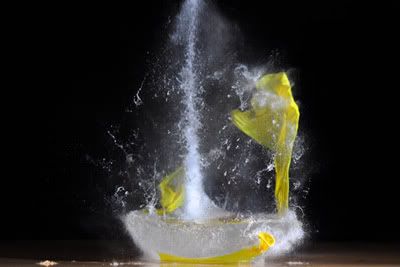I'll just emphasize here that the flash does not meter off the selected focus point , the change has nothing to do with the way the flash system meters .
This will also only happen in TTL-BL mode and with Nikon's CLS wireless flash which also meters in TTL-BL mode . The possibility of it happening falls within a very small window of the metering system - when the meter detects under-exposure causing the flash system to compensate by increasing output , or conversely by decreasing output if it detects that the exposure is suddenly correct after it showing as being under-exposed .
The possibility of this happening when a focus point is moved also depends heavily on the metering mode selected [ it must be matrix metering ] and how matrix metering works in that particular body - because it varies between models .
I used the Nikon D90 in these tests , I've tested the matrix metering system before and understand [ to a degree] how it 'thinks' .
In many of the Nikon's [ not too sure about Canon ] matrix metering is strongly weighted toward the selected focus point and the 'focus plane' that it sits on , and it adjusts exposure accordingly .
This means that if you are photographing a landscape and move the focus point from bright sky to shadow area "in the same frame" your exposure could vary by as much as two stops without even moving the camera .
Now it has been suggested that the changes seen in flash output are not due to the metering but rather due to the change in distance info from the lens which affect the output of TTL-BL flash [ not wireless which doesn't use the distance info ] .
This will cause changes as well but not the type I am demonstrating here . I have selected a scene in which the darker object which causes the an increase in output , is actually closer than the lighter object proving that the change in this case is not related to distance info from the lens .
Here is my test scene , the back of a camera closer to the camera with a white multi-plug adapter further back .
Theoretically when I change the focus point from the white object to the black object closer to the camera the flash exposure should decrease as the lens registers a closer focus point .
First I take a picture with the focus point moved onto the white object :
Then I move it onto the black object closer to the camera .... the flash exposure increases !?!
Why did that happen ?
Well TTL-BL and wireless CLS 'watch your meter" and adjust output accordingly .
Here's the back of the screen in the first shot :
The camera's meter was happy with the exposure with the focus point on the white object - that 'focus plane' decided that the camera's settings were correct for the scene so the camera told the flash to back off accordingly .
After taking the picture I simply moved the focus point onto the black object closer to the camera , which should have backed off the flash according to the distance info , but when the 'focus plane' shifted and the white object was no longer a dominant part of matrix metering's equation it decided that the image was under-exposed and the meter moved to "-1"
No camera settings were changed , the focus point was simply moved .
The flash output was increased because matrix metering decided that the scene , for that focus point , was under-exposed and so it decided to increase the flash output accordingly !
So this proves that regardless of the changes caused by the distance information from the lens , there are isolated instances where flash output can be affected by moving the focus point in the same scene with no other changes to the camera's settings :) .
Subscribe to:
Post Comments (Atom)









Sorry, me again. I'm going to test this myself, but if you focus on (for example) someones face using the centre focus point, and then recompose to have the face slightly to the right of frame, will the TTL/BL behaviour remain the same?
ReplyDeleteMatt
Yes , it will meter for the brightest area within the focus point diamond whether it's in the centre of the frame or to the side .
ReplyDeleteAs long as your subject is under a focus point the output should be very much the same .